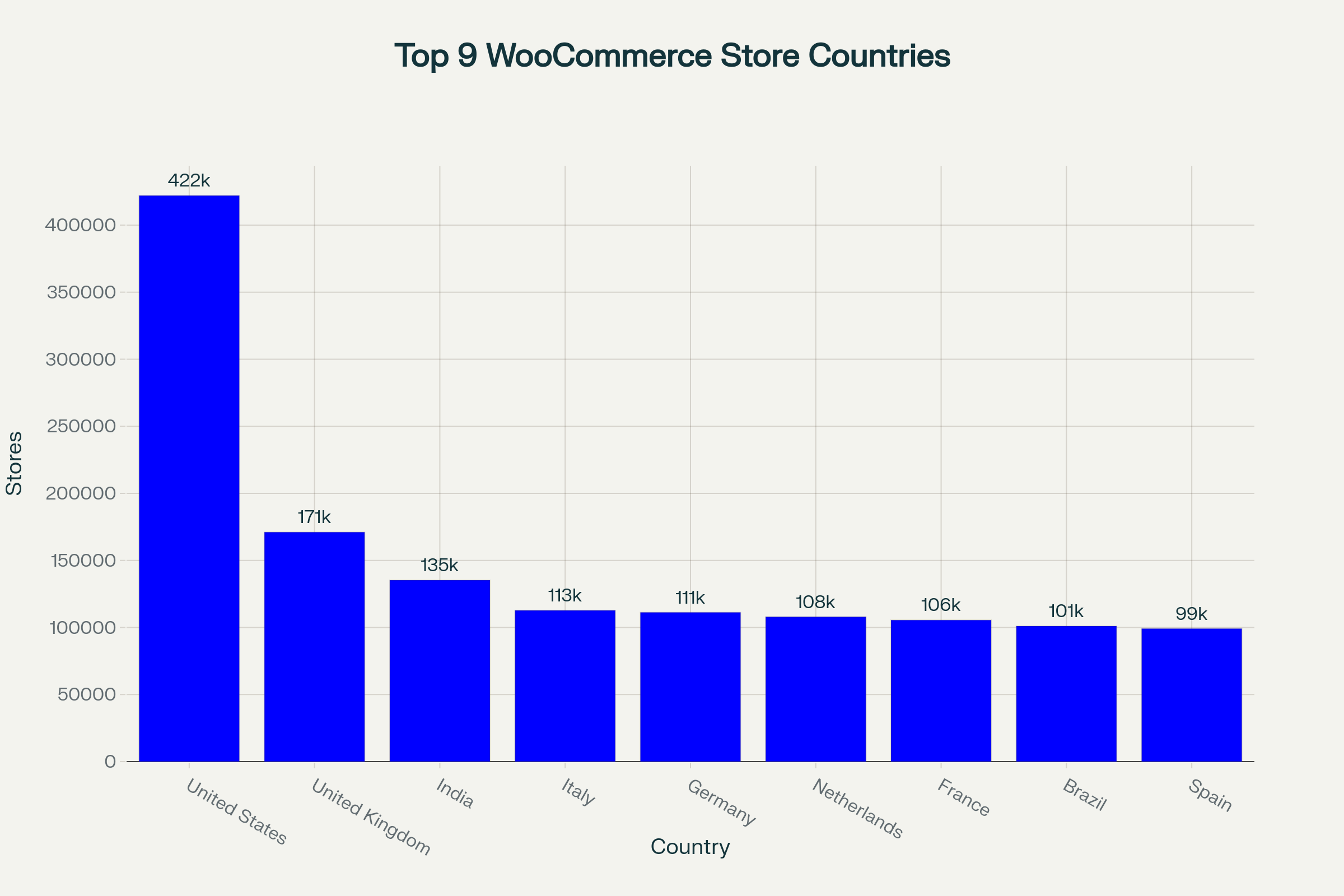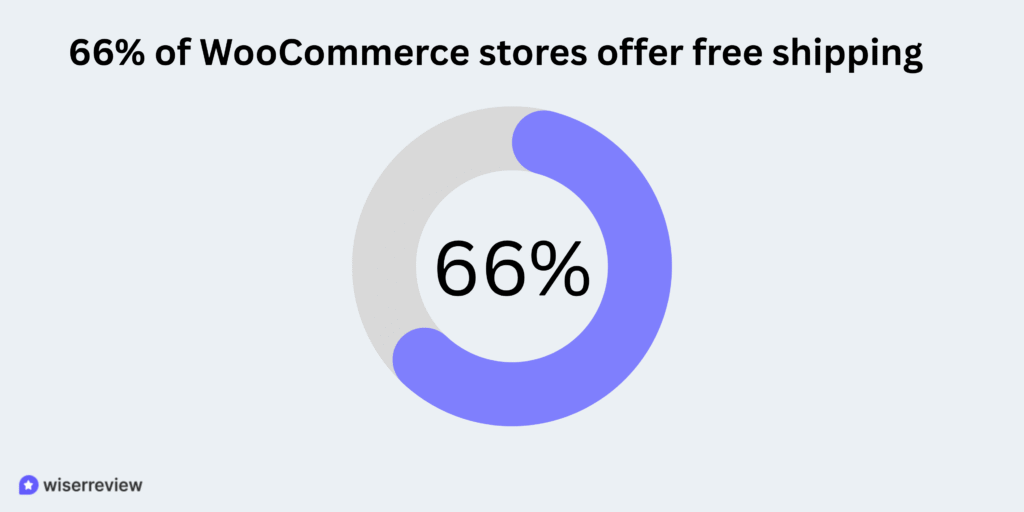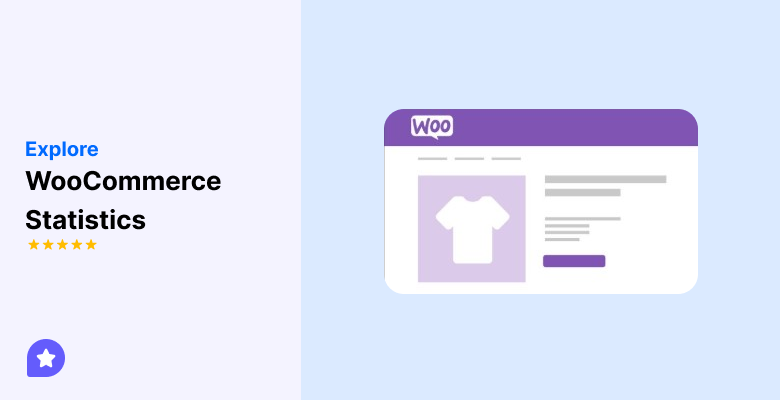WooCommerce is one of the most used ecommerce platforms in the world. Built on WordPress, it gives anyone the power to start and manage an online store without paying monthly platform fees.
Millions of small shops, local brands, and global businesses use WooCommerce to sell everything from digital products to physical goods.
It offers complete control over design, plugins, and payment options, which makes it stand out from hosted platforms like Shopify.
With strong community support, steady updates, and wide plugin access, WooCommerce continues to lead as a flexible and cost-effective choice for online sellers.
Quick highlight

WooCommerce is a top player in the eCommerce industry with millions of users and growing revenue.
These key stats show its size and reach:
WooCommerce powers over 6.5 million websites.
It holds around 33–39% of eCommerce sites globally.
Annual WooCommerce sales reach $30–35 billion.
55% of WooCommerce revenue comes from the US, UK, and India.
Over 59,000 compatible plugins exist in the WordPress plugin directory.
WooCommerce Checkout processes 23% of online orders worldwide.
Approximately 12,600 stores earn more than $ 100,000 per year.
WooCommerce supports 200+ countries and multiple currencies.
All your reviews in one place
Collect reviews, manage every response, and display them where they matter most.
General WooCommerce statistics
WooCommerce’s open-source nature makes it one of the most flexible tools in the online retail industry. It offers powerful features at a low cost, ideal for small and mid-sized stores.
1. WooCommerce runs on over 6 million live websites.
2. Around 3.5 million stores actively use WooCommerce checkout.
3. Approximately 10% of all WordPress sites feature WooCommerce.
4. WooCommerce powers roughly 4–5% of all websites on the internet.
5. The official WooCommerce site reports millions of plugin downloads each year.
6. WooCommerce stores generate millions of orders every day.
The platform supports both physical and digital products, from garden tools to software.
WooCommerce’s market share in the ecommerce space

WooCommerce remains a leader among all eCommerce platforms, supported by its free setup and WordPress integration.
7. WooCommerce holds 33–39% of all global eCommerce sites.
8. Shopify holds 19–26%, making it the closest rival.
9. Wix Stores control about 11% of the market.
10. Magento (Adobe Commerce) holds around 3%.
11. BigCommerce accounts for less than 1%.
12. WooCommerce is the #1 platform in Italy with a 26% share.
13. It holds 25–30% of the eCommerce market across Europe.
14. In the United States, WooCommerce powers about 15% of online stores.
WooCommerce usage statistics
WooCommerce’s reach continues to grow due to its strong link with WordPress CMS and ease of customization.
15. WooCommerce operates in 200+ countries worldwide.
16. It adds about 1,000 new stores daily.
17. 55% of WooCommerce’s total revenue comes from the US, UK, and India.
18. WooCommerce powers millions of online shops in different languages and currencies.
WooCommerce user demographics

WooCommerce attracts users from a diverse range of businesses, including individuals and large online brands.
19. The United States dominates WooCommerce adoption with 422,024 stores, accounting for 9.4% of all WooCommerce installations globally. The United Kingdom follows with approximately 171,056 stores (3.7%), while India rounds out the top three with 135,274 stores (2.6%).
20. About 60% of WooCommerce users are small business owners.
21. 25% are developers or freelancers managing client stores.
22. Over 300 stores make more than $1 million in yearly sales.
WooCommerce is used by both product sellers and service providers.
WooCommerce integration and features
WooCommerce supports a range of built-in and third-party tools to enhance store performance and improve the customer experience.
23. WooCommerce supports 65+ payment gateways.
24. About 45% of WooCommerce stores use email marketing integrations.
25. Over 70% of users utilize a cart recovery plugin to prevent lost sales.
26. Around 22% of stores use a wishlist plugin.
WooCommerce integrates seamlessly with marketing strategies, including retargeting and automation.
All your reviews in one place
Collect reviews, manage every response, and display them where they matter most.WooCommerce plugin usage and popularity

Plugins are the backbone of the WooCommerce ecosystem. Store owners rely on them to add new advanced features without coding.
27. There are over 59,000 WordPress plugins compatible with WooCommerce.
28. WooCommerce stores and supports 13,000+ themes.
29. 66% of WooCommerce stores offer free shipping, indicating this strategy as a key competitive tactic for encouraging purchases. The average shipping cost for orders stands at $17.
30. The official WooCommerce Marketplace lists 1,200+ premium extensions.
31. WooCommerce plugin downloads average 30,000 per day.
32. Stores that use 10 or more plugins often require performance optimization.
33. WooCommerce POS extensions connect over 80,000 retail outlets.
WooCommerce themes and design trends
WooCommerce’s sales volume continues to rise as more merchants move to online retail.
34. WooCommerce stores generate $30–35 billion in yearly sales.
35. Around 12,600 stores make over $100,000 per year.
36. WooCommerce’s revenue share equals 5–7% of total online retail sales.
The average order value for WooCommerce stores continues to grow year-over-year. WooCommerce’s GMV has doubled since the previous year.
WooCommerce sales and revenue
Performance directly impacts WooCommerce’s success, particularly for mobile devices and extensive catalogs.
37. WooCommerce sites that load in under 2 seconds see a 40% higher conversion rate.
38. Using caching or a CDN can reduce page load time by up to 50%.
39. PayPal follows at 28% adoption, maintaining brand trust among customers, while other gateways comprise 24% of total usage.
WooCommerce store performance
WooCommerce continues to improve through updates, automation, and better tools.
40. More than 60% of WooCommerce users reported using the mobile app to check store performance, process orders, and update inventory on the go.
Mobile and WooCommerce

Mobile shopping now drives the majority of online sales, and WooCommerce is designed to handle it.
41. About 70% of WooCommerce sales come from mobile devices.
42. Stores that load in under 3 seconds on mobile see higher engagement and sales.
The WooCommerce app helps store owners track orders and products from anywhere. Most WordPress themes are mobile-friendly by default, and fast payment options like Apple Pay and Google Pay make checkout easier.
WooCommerce checkout and conversion rates
43. A fast, simple checkout helps WooCommerce stores sell more. WooCommerce Checkout now handles about 23% of all online orders globally.
44. The average conversion rate for WooCommerce stores is around 2.5%–3%. Stores that use one-page or express checkout plugins often see 30% higher conversion rates.
45. Guest checkout can reduce cart abandonment by up to 20%, while fast-loading checkout pages boost completed sales by 40%.
WooCommerce growth trends
46. WooCommerce continues to expand each year with new plugins and tools. The platform averages about 30,000 daily downloads from the WordPress plugin directory.
47. More than 45% of stores utilize automated marketing tools, and AI-based pricing and product recommendation plugins are gaining popularity in use.
48. WooCommerce’s global presence has grown by 14% year-over-year, demonstrating steady worldwide adoption.
49. Growth is expected to continue at over 15% annually through 2025, with projections of 8 million active stores by year-end 2025.
50. Market analysts project WooCommerce to maintain 30-35% market share through 2027, driven by WordPress ecosystem growth and cost advantages, while potentially losing premium segment market share to Shopify.
The future of WooCommerce

WooCommerce’s future looks strong, thanks to its constant updates and a growing community.
The platform is expected to grow by about 10–12% in store count.
It continues to improve in speed, design, and data management, helping store owners run smoother operations.
What’s coming next for WooCommerce:
- AI-powered dashboards for more brilliant sales insights and forecasting.
- Faster performance and better site optimization tools.
- Improved analytics for tracking customer behavior and product trends.
- Multi-currency support for global sales.
- More mobile payment options like Apple Pay, Google Pay, and regional wallets.
- Tighter WordPress integration for seamless store management and content control.
With its open-source setup, flexibility, and link to the WordPress CMS, WooCommerce will continue to be one of the top eCommerce platforms in the years ahead.
All your reviews in one place
Collect reviews, manage every response, and display them where they matter most.Conclusion
WooCommerce remains a leader in the eCommerce industry with strong market share statistics, millions of active WooCommerce sites, and a growing community.
Its free, open-source structure, massive plugin library, and easy setup on the WordPress platform make it one of the most flexible ways to build online stores.
As more store owners focus on enhancing customer experiences and effective marketing strategies, WooCommerce’s extensive ecosystem ensures it will continue to grow through 2026 and beyond.
Frequently asked questions
WooCommerce is one of the most used eCommerce platforms in the world. It powers millions of online stores and continues to grow because of its connection with WordPress and open-source flexibility.
As of 2026, WooCommerce powers over 6.5 million live websites. It remains one of the most used eCommerce platforms globally, holding about 33–39% of total eCommerce sites.
WooCommerce stores generate around $30–35 billion in yearly sales. About 12,600 stores make more than $100,000 per year, while over 300 stores earn above $1 million annually.
Earnings vary by business size, but many WooCommerce stores make thousands of dollars each month. A large number of stores also cross six-figure annual revenue, showing strong potential for both small and mid-sized businesses.
Store owners choose WooCommerce because it’s free to install, easy to customize, and works well with thousands of WordPress plugins and themes. It gives full control over design, payments, and data unlike hosted platforms that charge monthly fees.

 4 min
4 min 





